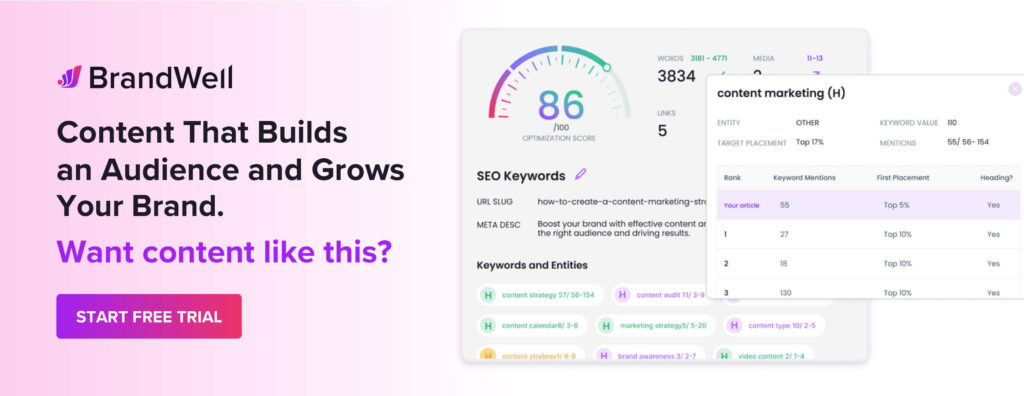Discover top guides, trends, tips and expertise from AIO Writers
What Are Sales Leads? Everything You Need to Know About Lead Generation
Farnaz Kia
Monday, 10th Feb 2025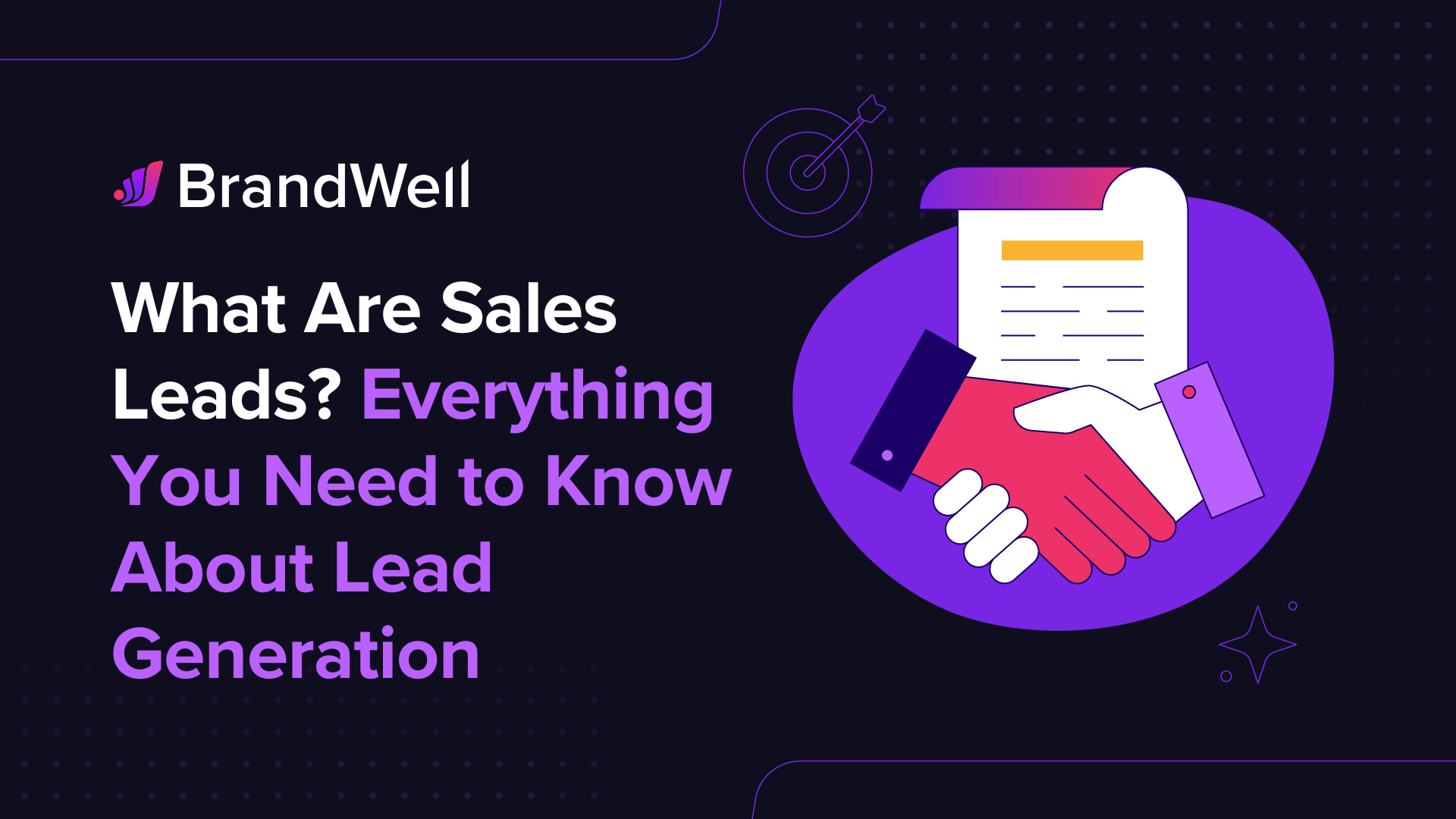
Sales leads are a big deal, especially when companies generating high-quality leads see 50% more sales-ready opportunities at a 33% lower cost than those who don’t focus on lead quality.
But what exactly are sales leads? And how do they go from a mere name on a lead database to a loyal client?
This guide will walk you through everything you need to know about sales leads, from how they’re generated and classified to the essential steps for turning leads into customers.
Plus, we’ll give you a sneak peek into this new visitor identification tool called TrafficID — a tool that can identify anonymous individuals who visit your website (instead of companies), which could totally change the way you generate, qualify, and reach out to sales leads.
Ready to dive into the world of sales leads and discover how to grow your customer base effectively? Let’s get started.
Table of Contents
What Are Sales Leads?
A sales lead is a person or business that has shown some level of interest in your product or service but isn’t looking to buy (yet).
They’re people who might have clicked on your ad, signed up for your newsletter, downloaded a free guide, or visited your website a few times. Each lead represents a potential future customer, giving your sales team a chance to build a relationship that could eventually lead to a sale.
Sales Leads vs. Sales Prospects
At first glance, “sales leads” and “sales prospects” might sound like the same thing, but there’s an important difference between the two.
A sales lead is someone who has shown interest in your product or service but hasn’t been fully vetted or qualified. Leads are often in the early stages of the buyer journey — perhaps just exploring options without a clear intent to buy.
On the other hand, a sales prospect is a lead who’s gone through some initial qualification steps and is more likely to become a customer. Prospects have specific characteristics or needs that align with what you offer. They’re past the initial interest stage and are actively considering solutions. In other words, prospects are closer to being ready for a conversation with your sales team.
How to Find Sales Leads
Sales leads are more than just names in a database — they play a crucial role in the customer journey from interest to purchase. They can come from a variety of sources: online ads, social media, referrals, events, and even word-of-mouth recommendations.
So how do you find these sales leads if they don’t leave their contact information?
There are two ways to identify anonymous website visitors: 1) you can use Google Analytics to get broad insights about your web traffic, or 2) you can use a website visitor identification tool that tracks IP addresses to find out which companies have visited your site.
One tool that stands out in the second category is BrandWell’s TrafficID. Going beyond company-level insights, this tool identifies actual individuals who are visiting your site, providing you with detailed information such as name, email, phone number, job role, LinkedIn account, and even behavioral insights such as which pages they visited on your website, how long they stayed there, and how many times they came back.
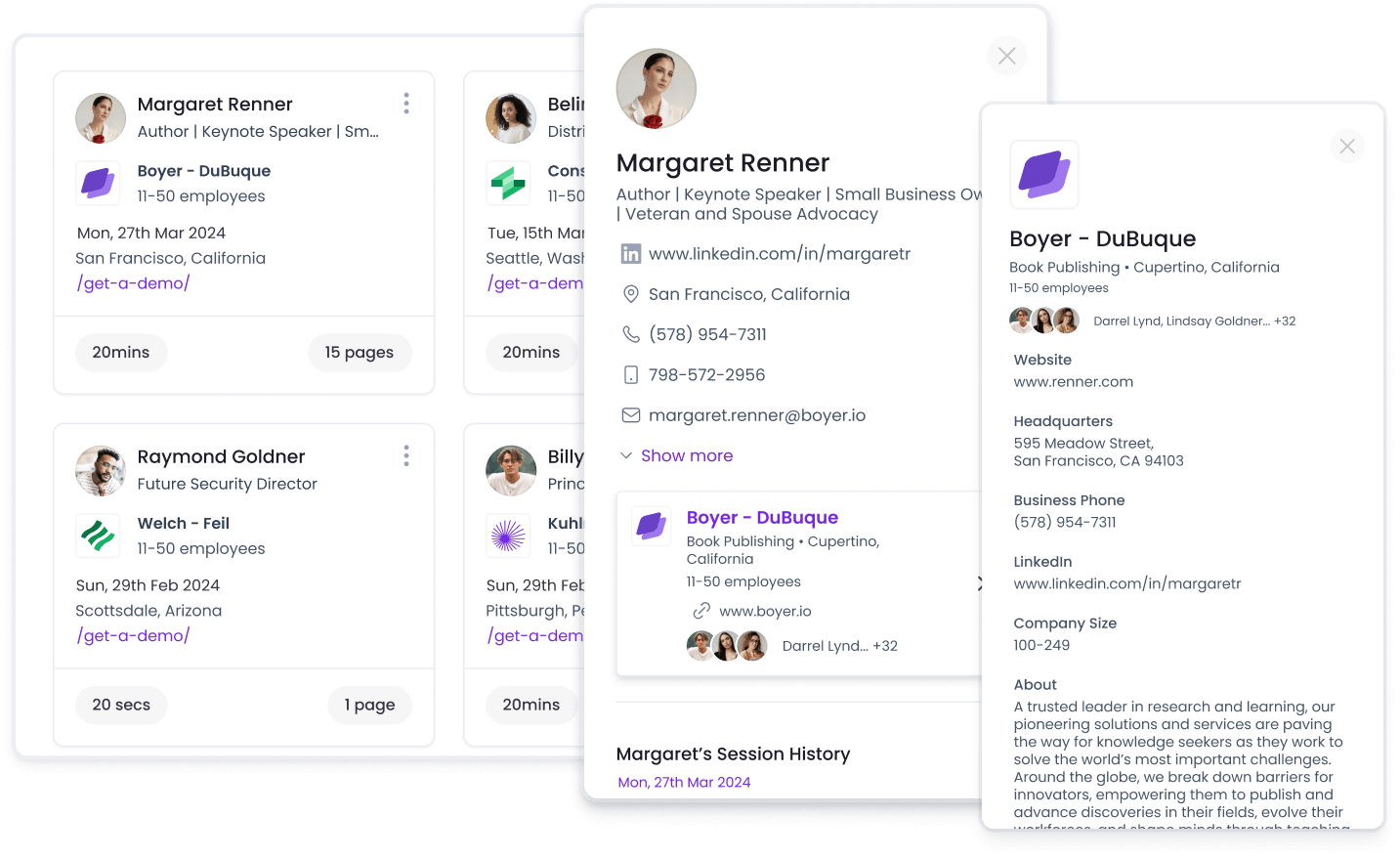

By capturing anonymous visitors and turning them into identifiable leads, TrafficID allows you to connect early with potential customers who have shown interest in your offerings.
Watch the video below to learn more about TrafficID 👇
Types of Sales Leads
Sales leads come in all shapes and sizes, and knowing the different types can help you better tailor your approach. There are six common types of sales leads.
1. Hot Leads
Hot leads are ready to buy. They know what they want, have already done their research, and just need a little nudge to complete the sale.
Hot leads might come from someone who reaches out directly to ask about pricing or requests a product demo.
For example, a hot lead could be someone who has already added items to their shopping cart and is reaching out with a final question about shipping.
2. Warm Leads
Warm leads are interested but aren’t quite ready to commit. They may need more information or have specific questions about how your solution fits their needs.
Warm leads often respond well to consistent engagement and value-added content that moves them closer to a decision.
For instance, a warm lead might be a person who downloaded a product guide and follows up with questions about certain features but hasn’t requested pricing yet.
3. Cold Leads
Cold leads are at the very beginning of the journey. They may have shown interest in your brand, but they’re not actively looking to buy just yet.
Cold leads might need more education about your product or solution, as well as reassurance on how it benefits them.
A person who signed up for a newsletter or followed your brand on social media but hasn’t interacted further would be considered a cold lead.
4. Information Qualified Leads (IQL)
Information Qualified Leads are people who’ve shown interest in learning more about your industry or specific topic but haven’t demonstrated buying intent.
These leads are in the research phase and often respond well to educational content, like e-books, whitepapers, or webinars.
An IQL might be someone who downloads an industry report from your website. While they’re gathering information, they’re not necessarily ready to purchase your product.
5. Marketing Qualified Leads (MQL)
A Marketing Qualified Lead is someone who’s shown a high level of interest in your product and fits your target audience but isn’t ready for direct contact from the sales team.
MQLs typically interact with multiple pieces of content and may have subscribed to your email list or engaged with product-related pages on your website.
An MQL could be someone who attended a product webinar, downloaded a case study, and subscribed to a weekly newsletter, showing sustained interest.
6. Sales Qualified Leads (SQL)
Sales Qualified Leads are highly engaged and meet specific criteria that indicate they’re ready to speak with a salesperson.
SQLs have shown a clear buying intent — maybe by requesting a demo, signing up for a trial, or directly reaching out for information on pricing or contracts.
An SQL might be a person who requested a custom quote or scheduled a call with your sales team to discuss specific product needs. This indicates a high level of readiness to make a purchasing decision.
By classifying leads effectively, you can provide the right content and outreach at the right time, making your sales process more efficient.
How the Lead Generation Process Works
Lead generation is the backbone of a thriving sales funnel. It’s the system that helps you attract, capture, and nurture leads, transforming initial interest into genuine purchasing intent.
Step 1: Attracting Leads
The process starts with getting noticed. This can happen through various channels, including social media, search engine optimization (SEO), content marketing, paid ads, and events.
At this stage, your goal is to raise brand awareness and draw in potential customers with engaging content, value-driven offers, and targeted messaging. The idea is to grab their attention and encourage them to explore your brand further.
For example, a fitness company might attract leads by offering a free guide on “Healthy Meal Prep for Beginners” through a Facebook post. People interested in fitness and nutrition click on the link to download the guide, becoming leads in the process.
Step 2: Capturing Leads
Once you’ve piqued someone’s interest, the next step is to gather their information. This typically involves creating a lead magnet (like an e-book, free trial, or discount code) in exchange for contact details. Using lead capture forms on your website or landing pages, you can obtain basic information, such as a name and email address, which allows you to engage further.
For example, an e-commerce store might offer a 15% discount in exchange for signing up for their newsletter. This provides a strong reason for people to join the mailing list.
Step 3: Qualifying Leads
Lead qualification is where you assess each lead’s potential to become a customer. This step often involves scoring leads based on specific criteria like engagement level, demographic details, or expressed interest.
Qualified leads are identified as promising and are moved further along the funnel, while less-engaged leads may be put into a nurturing process. Visitors who have viewed the pricing page and downloaded a case study are often considered highly qualified, while someone who only clicked on the homepage is less likely to be sales-ready.
TrafficID can help you qualify incoming leads. For example, it will tell you if someone just read one blog post and was on the site for 30 seconds — probably not worth reaching out — or if someone started on a blog post then went to the pricing page, scrolled down 60% of the way, and stayed for 55 seconds — making them a better potential lead and someone worth reaching out to.
Want to know how to qualify sales leads? Read our complete guide here.
Step 4: Nurturing Leads
Leads rarely convert right after the first interaction, which is why you need to “nurture” them. Lead nurturing involves guiding leads through the buying journey with relevant content, personalized emails, and follow-ups that build trust and familiarity.
According to HubSpot, 96% of prospects only engage with a sales rep after they’ve researched and short-listed their options. This makes it crucial to nurture leads early, keeping your brand top-of-mind throughout their research process.
Effective nurturing anticipates a lead’s needs, offering solutions and information that keep them engaged and move them closer to a purchasing decision.
For example, a B2B company might send a lead a series of emails with customer success stories, product tutorials, and industry insights based on the lead’s expressed interests, ensuring they remain engaged and informed.
TrafficID can help in the lead nurturing process by providing actionable insights into lead behavior. It allows you to identify high-potential accounts from site visits so you can qualify leads faster and focus on those more likely to convert.
For example, if multiple people from the same company visit your site, it could mean they’re very interested in your product.
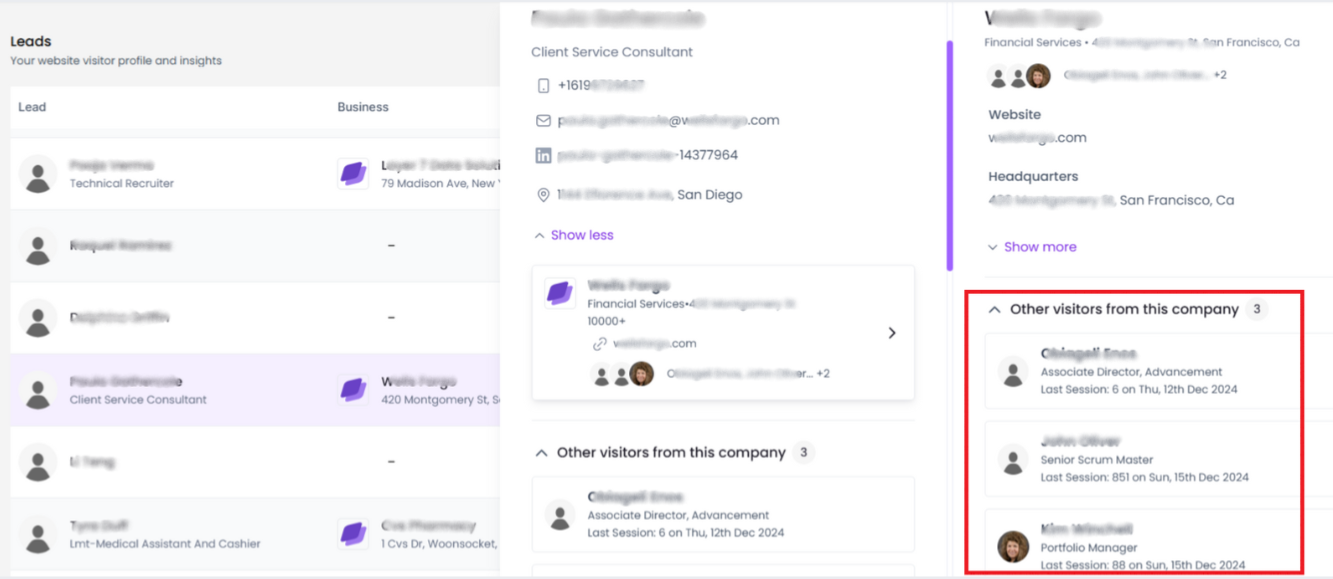

Learn how to develop an effective mail cadence using TrafficID visitor insights.
Step 5: Converting Leads
When a lead is deemed ready to buy, they’re passed to the sales team for direct engagement. At this point, the sales team focuses on closing the deal through demos, consultations, or special offers that address the lead’s specific needs. The goal is to make the transition from prospect to customer as smooth and timely as possible.
For example, a software company might schedule a personalized product demo for a qualified lead, showcasing how the tool addresses its unique pain points, ultimately leading to a purchase decision.
The sales lead generation process is a cycle that, when executed well, continually brings in new leads and turns them into paying customers. It’s a dynamic, multi-step approach that involves both marketing and sales teams working together to drive meaningful engagement and long-term growth.
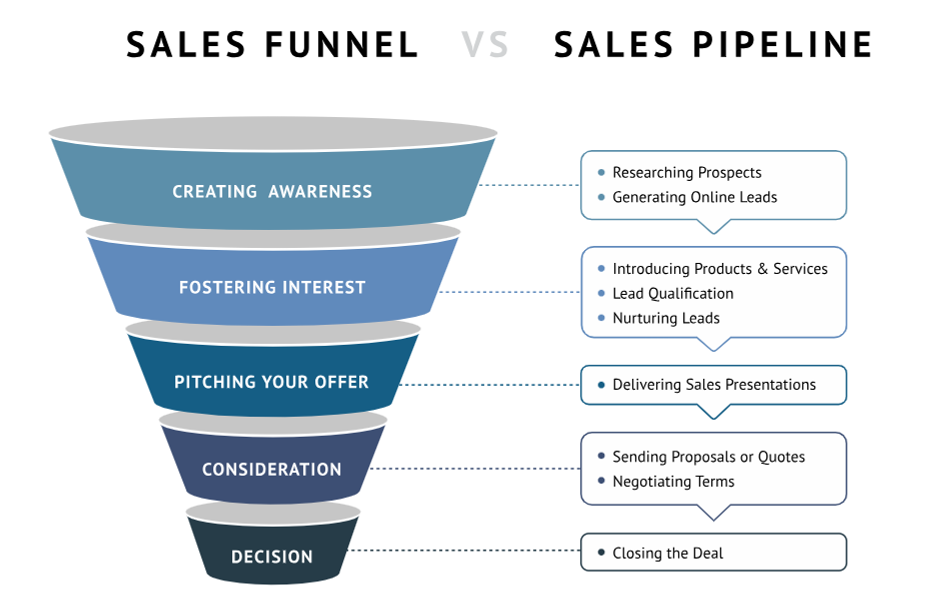

Image source: Fit Small Business
8 Ways to Attract Sales Leads
Generating sales leads is all about meeting potential customers where they are and offering the right incentives for them to engage with your brand. A variety of methods and channels can help you attract quality leads, and using a mix of these ensures you reach your audience across different platforms and touchpoints.
Here are some of the most effective methods and channels for lead generation:
1. Social Media Marketing
Social media platforms are great for building brand awareness and engaging directly with potential leads. Platforms like LinkedIn, Facebook, Instagram, and Twitter allow you to share valuable content, answer questions, and build relationships.
Paid ads on social media can also be highly targeted, helping you reach specific demographics or interest groups.
For example, a B2B company might use LinkedIn to share thought leadership content, attracting leads interested in their industry insights and establishing the company as an authority in the field.
2. Email Newsletters
Email marketing is one of the most reliable ways to nurture leads. By segmenting your email lists, you can send targeted content based on a lead’s specific interests or actions.
Regular newsletters, product updates, and exclusive offers keep leads engaged and provide a steady flow of relevant information.
An online retailer might segment its list based on browsing history, sending personalized product recommendations to leads based on items they’ve viewed.
3. Cold Calling
Traditional cold calling can still be an effective way to reach leads, especially in B2B industries. With a well-crafted script and a targeted list of contacts, cold calling can help open doors to new relationships and offer a personal touch that digital methods may lack.
For example, a software company might cold call leads in their target industries to offer a free product demo, breaking the ice and generating interest.
With TrafficID, your sales team can prioritize cold calls by focusing on leads who have already visited high-value pages (like product or demo pages) on your website. This data-driven approach helps tailor cold call scripts to the lead’s specific needs and pain points, increasing the chances of a positive response.
Know when to cold call, email, or text for better results.
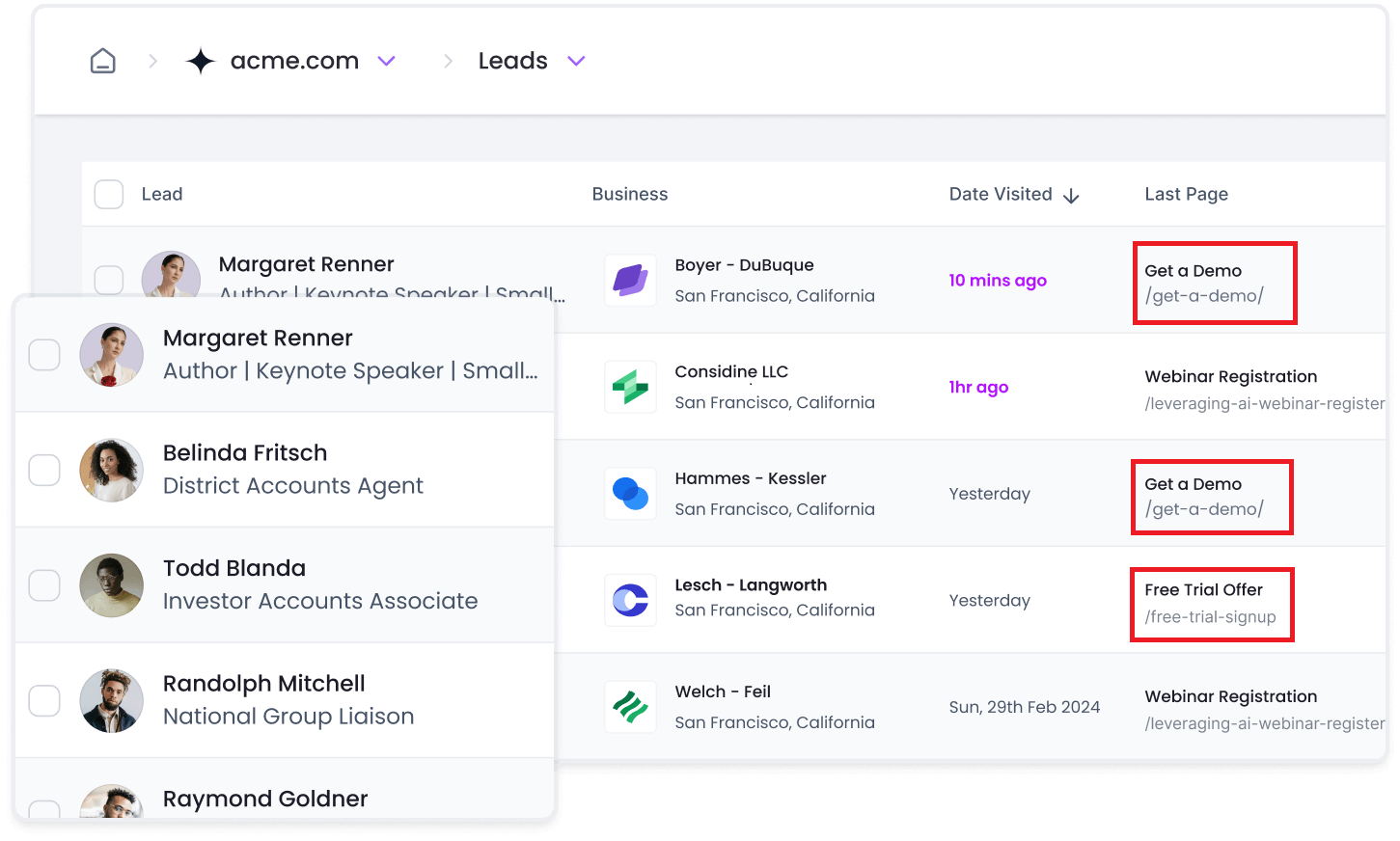
4. Search Engine Optimization (SEO)
SEO helps your business appear in search engine results when people look for solutions in your niche. By optimizing your website content with relevant keywords, you can attract organic traffic from people actively searching for what you offer, positioning yourself as a top choice for inbound leads.
A fitness app might optimize its blog content around keywords like “best fitness app for beginners,” attracting leads who are searching for exactly that.
TrafficID can identify companies visiting your site via organic search traffic, helping you understand the types of businesses interested in your content. For example, if most of your visitors are university professors, you can tweak your SEO strategy to focus on keywords and topics that are relevant to them.


5. Paid Search Advertising
Paid search ads (PPC) let you target specific keywords on search engines like Google. These ads appear above organic results, helping you attract high-intent leads who are actively searching for relevant terms.
While it involves an investment, PPC campaigns can deliver quick results and measurable returns.
For example, a moving company might use PPC to appear for keywords like “best moving company in San Francisco,” reaching leads who are ready to book services.
6. Display Advertising
Display ads appear on various websites across the internet, helping you raise brand awareness among a broader audience. These ads are visual and can be placed on relevant websites to capture the attention of leads who fit your target demographics.
An e-commerce store might display banner ads on popular lifestyle blogs or websites that align with their ideal customer’s interests.
7. Traditional In-Person Networking
Face-to-face interactions like attending industry conferences, trade shows, and local events can yield valuable connections. Networking allows you to engage directly, answer questions in real time, and build personal relationships that are often more memorable than online interactions.
A financial services firm might attend a regional business conference, meet potential clients in person, and follow up after the event.
8. Upselling to Existing Customers
Your current customers can also be a rich source of new leads, either through direct upselling or referrals. Offering complementary products, upgrades, or loyalty rewards can encourage satisfied customers to continue buying from you and even recommend your brand to others.
For example, a SaaS company might offer a discount on an upgraded plan for existing users, generating leads for higher-value services while building loyalty.
TrafficID monitors the browsing habits of returning customers on your website, revealing interest in related products or services. This insight helps sales teams focus on upselling opportunities for customers who are already showing signs of interest in higher-value offerings, enhancing customer retention and increasing revenue.
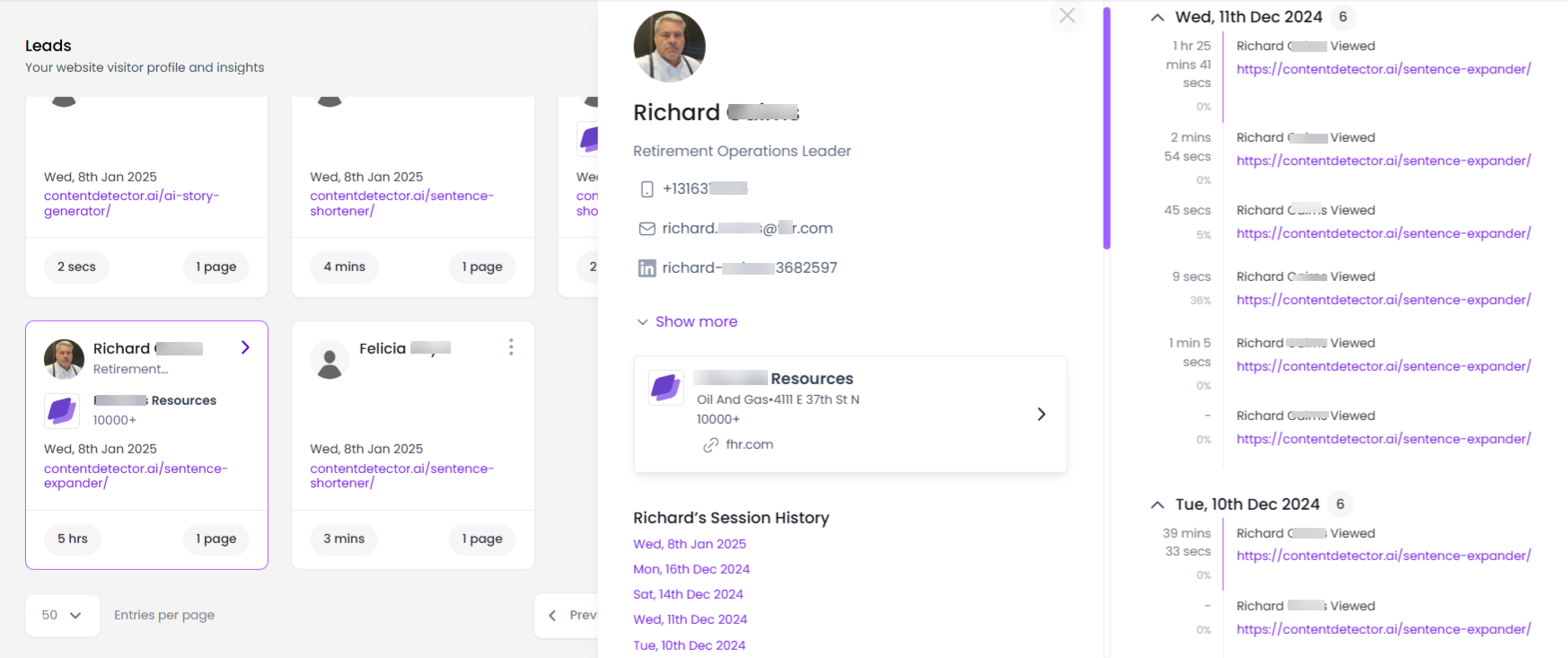

Implementing a combination of these tactics allows your business to cast a wide net while still targeting the right leads. By leveraging both digital and traditional channels, you can connect with potential customers at every stage of the buyer journey and guide them toward becoming paying clients.
How to Nurture a Lead
Now that you have a sales lead, it’s time to kick off the lead nurturing process.
Lead nurturing is about building relationships with your leads, guiding them through the buyer journey, and delivering value at each step.
Nurturing doesn’t just involve sending follow-up emails; it’s about consistently understanding a lead’s needs, answering their questions, and offering relevant solutions, all while keeping your brand top-of-mind.
Here’s how to nurture leads effectively:
1. Anticipate Needs Based on Lead Profile and Buying Stage
To nurture leads effectively, it’s essential to understand where they are in the buying process and what they might need next.
Are they still researching solutions? Or are they weighing your product against competitors?
If a lead is in the early research phase, sending them a case study or product comparison guide can be more effective than sending pricing details.
By knowing your lead’s profile and stage, you can offer them information that aligns with their journey and addresses their immediate concerns.
2. Provide Value with Every Interaction
Value-driven content is crucial in nurturing leads. Instead of focusing on sales messages, you can share insights, tips, or resources that demonstrate your expertise and highlight your brand’s value.
Educational content like webinars, how-to guides, or whitepapers can help leads understand the problem they’re trying to solve and why your product might be the solution.
For example, a lead management software company might send a lead a detailed e-book on “Improving Customer Retention” to highlight the importance of CRM tools in retaining clients, showcasing how their product addresses these pain points.
3. Build and Nurture Relationships
Personalized communication can make leads feel seen and valued. Tailoring messages based on a lead’s actions or expressed interests — like referencing specific content they’ve viewed or addressing a particular pain point they’ve mentioned — creates a sense of connection.
Addressing them by their name, recognizing past interactions, and speaking to individual needs can make a big difference.
For example, if a lead downloaded an e-book on content strategy, the next email could mention the e-book, offer additional content on related topics, or invite them to a webinar on “Advanced Content Strategies.”
4. Follow Up Consistently and Politely
Regular follow-ups keep leads engaged. To avoid overwhelming them, the key is to time your follow-ups appropriately and avoid coming across as too aggressive or sales-y.
Timely check-ins, thank-yous, and updates on new content or features are effective ways to follow up without pressuring the lead to make a decision.
Let’s say your lead attended a product webinar. You can send a follow-up email that includes a thank-you, a summary of the session, and a link to a product demo — letting them explore more without pushing for an immediate sale.
Learn how to write the perfect follow-up email and get your free template here.
5. Automate Lead Nurturing
Automation tools can help streamline lead nurturing by sending personalized messages and alerts based on a lead’s behavior and stage in the funnel.
Lead nurturing software can automatically send follow-up emails, offer relevant content, and even trigger alerts for your team when a lead shows significant buying signals, ensuring a timely and tailored response.
For instance, if a lead repeatedly visits the pricing page, your software could trigger a follow-up email offering a consultation or demo, or notify a salesperson to reach out directly.
How Technology is Transforming Lead Generation
Speaking of automation, technology has changed the way modern marketers and sales professionals generate leads.
With the rise of artificial intelligence (AI) and data-driven insights, businesses can now generate and qualify leads faster and more effectively.
Let’s take a closer look at how technology impacts each stage of lead generation.
1. Automated Lead Generation
Software solutions like CRM systems, email marketing platforms, and chatbots can automate repetitive tasks such as data entry, lead nurturing, and follow-up emails. This saves time, reduces human error, and ensures that leads are contacted at the right time.
For instance, marketing automation platforms like HubSpot or ActiveCampaign can send targeted email campaigns based on lead behavior, such as downloading an e-book or attending a webinar, ensuring timely follow-ups without manual intervention.
2. More Accurate Lead Scoring and Qualification
Lead scoring technology helps businesses prioritize leads by assigning values based on their behavior, interactions with your content, and demographic information. By evaluating a lead’s readiness to purchase, sales teams can focus their energy on the most promising leads, improving conversion rates and sales efficiency.
For example, Salesforce offers AI-powered lead scoring, which ranks sales leads based on website visits, email engagement, social media interactions, and other factors. The system automatically notifies your sales team about high-value leads ready for follow-up.
3. Data Analytics for Better Insights
Sales and marketing teams rely on data analytics to measure the effectiveness of their lead generation efforts. By using business intelligence software, you can track key metrics such as lead sources, conversion rates, and the behavior of potential customers, allowing for informed decision-making and campaign optimization.
For example, Google Analytics can help you monitor how well your landing pages are converting leads, allowing you to make adjustments to your messaging, layout, or calls to action to improve performance.
4. AI and Predictive Analytics
Artificial intelligence and predictive analytics are transforming the way businesses approach lead generation by forecasting which leads are most likely to convert. AI models analyze data from various sources — like past interactions, social media activity, and demographic details — to predict future behavior, helping sales teams prioritize leads with higher conversion potential.
Tools like Leadspace use predictive analytics to identify high-potential leads by analyzing patterns from historical data. This enables businesses to target the right leads at the right time, maximizing the chances of conversion.
5. Chatbots and Conversational Marketing
Chatbots are increasingly popular for lead generation, offering real-time engagement on websites. These AI-powered tools can instantly respond to visitor inquiries, qualify leads, and guide them through the buyer journey — often without the need for human intervention. This makes lead generation more efficient and helps businesses capture leads 24/7.
A chatbot on your website might ask visitors qualifying questions like “What’s your business size?” or “What service are you looking for?” and immediately pass the information to your sales team, all while gathering valuable lead data in real time.
6. Lead Enrichment Tools
Lead enrichment tools provide deeper insights into the leads you’ve captured, helping you understand them better and personalize your outreach.
Tools like Clearbit or ZoomInfo allow you to enrich lead profiles by gathering information from various online sources, enabling your sales team to tailor their outreach and better meet the needs of potential customers.
7. Lead Generation Software
Dedicated lead generation platforms are designed to streamline the process of capturing and qualifying leads. These tools typically offer a variety of features, including landing page creation, lead form builders, CRM integration, and lead tracking. By automating many steps of the lead generation process, these platforms make it easier for businesses to capture, qualify, and nurture leads.
BrandWell’s TrafficID tool is an excellent example of lead generation software that helps businesses identify website visitors in real time. This allows companies to engage with leads as soon as they land on their website, improving lead capture and conversion rates.
Want to generate 1,600+ fresh leads in two weeks? Find out how we did it with TrafficID:
How Long Does it Take for Sales Leads to Turn into Customers?
The timeline for converting a sales lead into a customer can vary widely depending on several factors, including the type of product or service, the complexity of the buyer’s decision-making process, and the lead’s position in the sales funnel.
However, understanding the typical timeline and what influences it can help businesses optimize their lead nurturing strategies and set realistic expectations for their sales teams.
1. Sales Cycle Length
The sales cycle is the amount of time it takes for a lead to move through the stages of awareness, consideration, and decision-making before finally becoming a customer. For some businesses, this cycle could be as short as a few days, while for others, it could span several months or even years.
B2C Sales: In consumer-facing businesses, particularly in industries like retail or SaaS with low-cost offerings, the sales cycle tends to be shorter. For example, a lead might convert within a week or two, especially if they’re responding to a limited-time offer or special promotion.
B2B Sales: Business-to-business sales cycles are often longer due to the complexity of the products or services, larger investments, and the involvement of multiple decision-makers. In B2B environments, the average sales cycle can range anywhere from 3 to 6 months, or even longer for high-ticket items.
2. Lead Qualification and Buyer Readiness
The level of qualification a lead has achieved plays a significant role in determining how quickly they’ll convert. A highly qualified lead (SQL) is much closer to making a purchase decision than a cold or even a warm lead.
Sales teams can shorten the conversion timeline by focusing on leads that show clear buying signals, such as engagement with high-value content (e.g., case studies or product demos), direct inquiries, or a history of purchasing similar products.
For instance, a lead who downloads your pricing guide or requests a demo is likely closer to making a purchase decision than someone who simply subscribed to your newsletter.
3. The Lead Nurturing Process
Effective lead nurturing can speed up the process by maintaining consistent communication and providing relevant content at each stage of the buyer journey.
For example, a lead who receives timely, personalized emails, educational resources, and product recommendations is more likely to stay engaged and move forward in their decision-making process.
Conversely, leads who aren’t nurtured appropriately may stall in the sales funnel, resulting in longer conversion times — or worse, lost opportunities.
4. Industry Factors
The industry you operate in also plays a significant role in determining how long it takes for a lead to become a customer.
In industries that require significant research or consideration (e.g., real estate, enterprise software, or consulting), the buying decision can take much longer. This is because prospects need time to evaluate the options, negotiate terms, and involve other stakeholders in the decision.
On the other hand, industries where products or services are more transactional or have a lower cost (e.g., e-commerce or digital products) tend to have faster conversion times.
5. External Factors
External factors such as market conditions, economic trends, and even seasonal buying patterns can affect how long it takes to convert a lead into a customer.
For example, during an economic downturn, businesses may take longer to commit to large purchases, while during a peak season or a major promotion, the conversion timeline may shorten.
How Can You Protect a Lead’s Private Information?
In today’s digital age, safeguarding the private information of sales leads is more important than ever. With cyber threats, data breaches, and privacy regulations on the rise, businesses must take proactive measures to ensure that sensitive lead data is kept secure and protected from unauthorized access.
Here’s how:
Adhere to Data Privacy Laws and Regulations
The first step in protecting lead data is ensuring compliance with data privacy laws such as the General Data Protection Regulation (GDPR), the California Consumer Privacy Act (CCPA), and other regional or industry-specific regulations.
These laws set clear guidelines on how personal data should be collected, stored, and used, and businesses must comply with these regulations to avoid penalties and build trust with their leads.
For example, if you’re operating in Europe, GDPR requires businesses to obtain explicit consent from leads before collecting their personal information. This means you must inform leads about what data you collect and how it will be used, while also giving them the right to withdraw consent at any time.
Secure Data Storage
Once a lead’s information is collected, businesses must store this data securely. Using encrypted storage solutions and cloud-based platforms with strong security protocols helps ensure that lead data is protected from hackers or unauthorized users.
Many businesses use advanced encryption technologies to encrypt sensitive data both at rest (stored data) and in transit (data being transmitted).
Many CRM platforms, like Salesforce, offer encryption options to secure sensitive lead data stored in their system. Cloud providers like Amazon Web Services (AWS) or Microsoft Azure also implement industry-leading security measures to protect data stored on their platforms.
Access Control and User Authentication
Limiting access to sensitive lead data is crucial in protecting its privacy. By implementing role-based access control (RBAC), businesses can ensure that only authorized personnel have access to specific lead information based on their role and responsibility. This can prevent unauthorized users within the organization from viewing or modifying sensitive data.
For instance, a sales manager might have access to all lead information, while a junior sales representative might only have access to leads they are directly handling. Businesses also can implement multi-factor authentication (MFA) to further strengthen the security of user accounts accessing lead data.
Data Anonymization
For businesses that handle large amounts of lead data, anonymization can be an effective method of protecting privacy. Data anonymization involves removing or masking personal identifiers such as names, email addresses, and phone numbers so that even if the data is exposed, it cannot be traced back to an individual.
Secure Communication Channels
When communicating with leads, businesses can use encrypted email services, secure online forms, and websites with SSL certificates to protect their privacy. Ensuring that sensitive lead information is transmitted over secure channels reduces the risk of data being intercepted during the exchange.
Now if you’re using a website visitor identification tool like TrafficID to capture leads, data privacy is obviously a major concern. Here are three tips to mitigate your risk:
- Clear privacy policy: Clearly state in your privacy policy what data is being collected, how it’s used, and how users can manage their privacy settings.
- Cookie consent banners: Provide a visible way for users to accept or decline cookies and tracking technologies.
- Opt-out options: Allow users to opt out of being tracked and delete the information that you may have about them.
In today’s digital-first world, protecting the privacy of sales leads is a top priority for businesses. By implementing strong data security measures, businesses not only build trust with potential customers but also mitigate the risks of financial and reputational damage.
From Sales Lead to Done Deal: 9 Tips to Close Efficiently
Closing a sale is the ultimate goal of the sales process, and it’s where the hard work of lead generation, qualification, and nurturing comes to fruition.
The transition from a sales lead to a closed deal can be tricky, but with the right strategies, it can be smooth and efficient.
Here are nine proven strategies to help improve your lead-to-sale conversion rates:
1. Build a Strong Relationship with the Lead
Relationship-building is critical in the sales process. Leads are more likely to become customers if they feel understood and valued. Take time to understand their pain points, preferences, and motivations. Personalize your communication to show that you’ve been paying attention to their needs.
- Active Listening: Engage with the lead by asking open-ended questions to better understand their challenges. By actively listening, you can tailor your solution to meet their specific needs.
- Trust Building: Provide value at every interaction such as offering relevant insights, case studies, or helpful resources. The more you demonstrate your expertise and reliability, the stronger your relationship with the lead becomes.
2. Create a Sense of Urgency
One of the best ways to motivate leads to take action is to create a sense of urgency. Limited-time offers, promotions, or highlighting the risk of missing out can nudge leads to move forward in the buying process. However, it’s important to do this authentically — avoid using fake urgency tactics, as it can damage your credibility.
- Limited Offers: Use time-sensitive discounts, bonuses, or promotions to encourage leads to take action before the offer expires.
- Scarcity Tactics: If applicable, let the lead know that the product is in limited supply or that availability is running low. This can encourage a sense of urgency without being pushy.
3. Personalize Your Sales Pitch
Personalization is key when closing a sale. Tailor your pitch to address the lead’s specific pain points and how your product or service can solve their problems. Use the information you’ve gathered throughout the lead nurturing process — such as their industry, challenges, and interests — to frame your offering in the most relevant way.
💡 Tip: Refer back to any previous interactions with the lead to show that you’ve been paying attention and are invested in helping them find the best solution.
Get more tips here on how to personalize your outreach effectively.
4. Offer Social Proof
Social proof is a powerful tool when it comes to closing deals. Leads are more likely to trust your product or service when they see that others have had positive experiences with it. This can be especially effective when closing deals with leads who may be on the fence.
- Testimonials and Case Studies: Share customer success stories (like this) and testimonials to demonstrate the value your product or service has provided to others in similar situations.
- Industry Recognition: Highlight any awards, recognitions, or positive press your company has received. This can build credibility and trust, nudging the lead closer to making a decision.
5. Offer Solutions, Not Products
Rather than focusing on selling the features of your product or service, emphasize how your solution can solve the lead’s specific problems. Show the lead how your offering fits into their broader goals or objectives and improves their situation.
- Benefit-Oriented Pitch: Explain how your product will save them time, increase efficiency, or drive revenue, depending on their needs. Focus on the why rather than the what.
- Customization: If applicable, offer customization options that can help meet their unique needs, making the solution feel more tailored to them.
6. Overcome Objections with Empathy
Objections are a natural part of the sales process, and addressing them with empathy can go a long way in closing deals. Rather than brushing off concerns, listen carefully, validate the lead’s concerns, and offer solutions.
For example, if a lead expresses concerns about the price, you could offer a payment plan or highlight the long-term value of the product.
💡Tip: Use the “Feel-Felt-Found” technique. “I understand how you feel. Others have felt the same way, but they found that once they implemented our solution, the ROI more than made up for the cost.”
7. Ask for the Sale
This may seem like an obvious step, but many salespeople hesitate to ask directly for the sale. At some point, you need to make a clear, confident call to action. If you’ve built rapport, addressed their concerns, and presented the benefits of your solution, asking for the sale becomes a natural next step.
When the moment feels right, don’t be afraid to ask for the sale. A direct call-to-action such as “Are you ready to move forward?” or “Can I help you with the next steps?” can often prompt the lead to make a decision. It might feel uncomfortable at first, but a confident, direct ask can help push the conversation over the finish line.
- Direct Close: A direct approach like, “Are you ready to move forward with the proposal?” can be very effective. If the lead has no further objections, they may be ready to commit.
- Trial Close: Before the final ask, you can use a trial close to test the waters, such as, “How does this sound so far? Does it align with your goals?”
8. Make the Close Easy
The easier you make the closing process, the more likely you are to seal the deal. Eliminate any unnecessary steps or roadblocks that might delay the purchase decision.
Offer a simple, clear, and easy-to-understand contract and guide your lead through the final steps. Also, consider using e-signature tools to make the process seamless and immediate.
Example: “I’ve already sent the contract over for your review. Once you’ve signed, we can get started right away!”
9. Follow Up, But Don’t Be Pushy
Sometimes, the best way to close a sale is simply to follow up consistently. Don’t let the lead fall through the cracks, but also be mindful not to bombard them with too many calls or emails. A gentle nudge can be all it takes to remind them of your offering and keep the conversation moving forward.
- Timely Follow-Ups: Send follow-up emails within 24 hours of a meeting or demo to recap the key points discussed and answer any lingering questions.
- Value-Focused Follow-Up: Rather than simply asking for the sale, offer additional value in your follow-up, such as an article, a case study, or a solution to a problem they mentioned during the conversation.
By employing these strategies and fine-tuning your approach, you’ll improve your chances of closing deals efficiently and converting sales leads into long-term customers.
Unlock Lead Opportunities with BrandWell’s TrafficID
According to MarketingSherpa, 79% of leads never convert to sales. No wonder 61% of marketers consider finding high-quality leads as their number one challenge.
In today’s competitive landscape, identifying potential leads as they visit your website is crucial for staying ahead. While traditional methods of lead generation often leave businesses waiting months for results, BrandWell’s TrafficID provides an instant solution. It helps you identify visitors to your website in real time, giving you detailed insights into who they are and what interests them.
What is TrafficID and How Does It Work?
TrafficID is a cutting-edge tool that allows you to identify and engage with actual individuals visiting your website. Rather than relying on anonymous metrics or guessing who’s interested, TrafficID provides specific details about each visitor.
Here’s how it works:
- Identify Visitors: TrafficID doesn’t just show you that someone visited your site — it reveals the individual’s identity. Whether it’s someone browsing your blog or checking out your services, you’ll know exactly who they are, even if they didn’t fill out a form. (Currently available in the U.S.)
- Detailed Insights: The tool provides in-depth data about the behavior of visitors. You’ll know which pages they visited, how long they spent on each, and the likelihood of them being a qualified lead. For instance, if a visitor spends significant time on your pricing page, they could be a hotter lead compared to someone who only reads a blog post.
- Company Information: If multiple individuals from the same company visit your site, TrafficID will reveal this connection. This can signal that the company is evaluating your offering, making them an important prospect to engage with.
- Integration with GoHighLevel and Zapier: TrafficID seamlessly integrates with popular CRMs like GoHighLevel, Zapier, WordPress, Shopify, and Magento — ensuring all lead data is automatically synced and ready for follow-up.
- Export Leads for Ads: You can export visitor data to create highly-targeted ad campaigns or use the data to find similar audiences, amplifying your marketing efforts and increasing conversion opportunities.
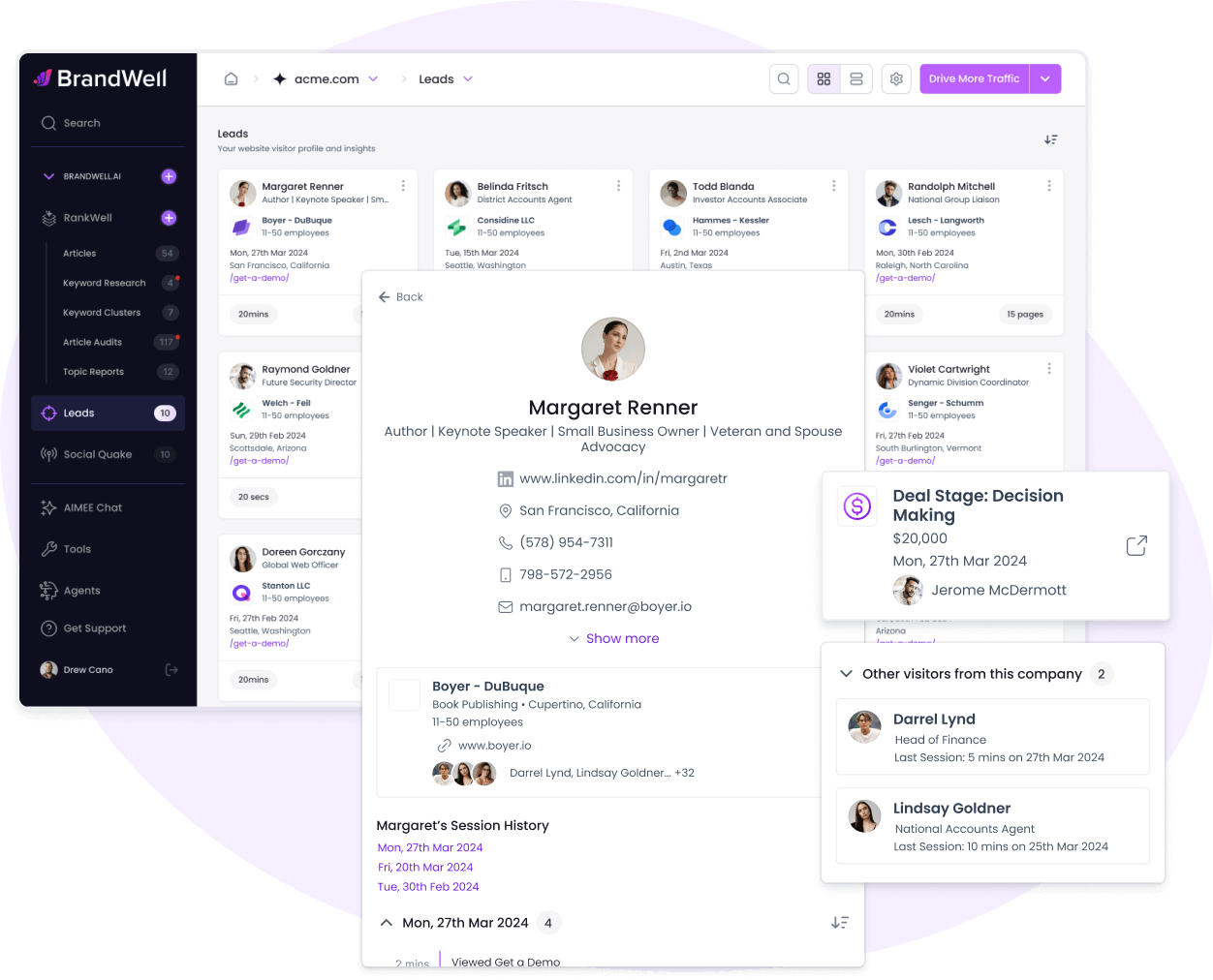

What Can TrafficID Do for You?
For businesses, TrafficID transforms anonymous website traffic into actionable insights, allowing you to engage with leads who are already showing interest in your offerings. No more guessing — know exactly who to reach out to.
For sales teams, TrafficID’s real-time lead identification can help you reach out to prospects who are already exploring your products or services, increasing the chances of a successful sale.
And for agencies, TrafficID helps you provide immediate value to your clients by offering real-time lead identification. This tool allows you to demonstrate ROI quickly, making your agency more valuable to clients who are eager to see results from their marketing efforts.
Instant Results: Generate and Convert Sales Leads with TrafficID
With BrandWell’s TrafficID, you can finally unlock the power of immediate lead identification. This tool gives you the insights you need to engage with website visitors as they browse, allowing you to act fast and reach out to the right people at the right time.
By leveraging this cutting-edge technology, you’ll never have to rely on guesswork or wait months for results. TrafficID will help you convert website visitors into loyal customers faster, improving your ROI and giving you a competitive edge.
Ready to see the power of real-time lead identification? Sign up for your free trial today and start turning your website traffic into valuable leads, instantly.

UNLOCK YOUR POTENTIAL
Long Headline that highlights Value Proposition of Lead Magnet
Grab a front row seat to our video masterclasses, interviews, case studies, tutorials, and guides.

